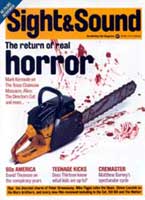
Decasia
USA 2002

Reviewed by Tony Rayns
Synopsis
Our synopses give away the plot in full, including surprise twists.
Decasia is an artful collage of found archival footage, all of it shot pre-1950 on a cellulose nitrate base and most of it in advanced stages of decay. The footage is slowed to allow a greater appreciation of the effect and character of the visual damage to the original materials, which include everything from fragments of silent melodramas to ethnographic studies, travelogues, newsreel footage and wildlife documentaries. The material is edited to a modernist symphonic score by Michael Gordon; the aural dissonance complements the visual decay.
Review
Bill Morrison calls his production company 'Hypnotic Pictures', and it's a billing that Decasia more than lives up to. An hour or so of fascinating distortions, underpinned by the throb of Michael Gordon's 'Symphony' (scored for a large orchestra and an electric guitar), recaptures something of the lysergic thrill of the first psychedelic lightshows in San Francisco's 'Summer of Love'. The fact that nitrate decomposition sometimes looks like deliquescent heat-blisters makes the visual resemblance to acid-rock backdrops all the stronger, and the appearance of several middle-eastern motifs in the opening minutes (notably a camel train plodding sedately along a desert horizon, shown in virtually undamaged footage; a solitary camel and its rider are seen returning whence they came in the closing minutes) triggers a further set of Grateful Dead/stoner trance associations. You can almost smell the kif.
In other ways, though, Decasia pulls against its own hypnotic effect. First, the film calls as loudly as Martin Scorsese at a film-preservation symposium for action to save the world's vanishing stock of nitrate films. The nitrate paradox is that pre-1950 film stocks yielded images of startling clarity and intensity, not to mention pellucid beauty, but the instability of the chemical base left those images as vulnerable as wilting petals. It's almost impossible to reproduce the visual qualities of a fine nitrate print on safety stock, and so Decasia cannot do full justice to the beauty of its source materials. But by presenting images that are in advanced stages of decomposition Morrison is agitating in the most powerful way on behalf of the archives fighting to rescue their holdings from disintegration. (Decasia is being screened in London with Morrison's 1996 short The Film of Her, a charming fantasy in which a man haunted by memories of a silent stag movie becomes a pioneering archivist.)
Second, Morrison has chosen images for the film which, as he puts it himself, seem to be resisting their own decay: "I was always seeking out instances where the image was still putting up a struggle, fighting off the inexorability of its demise but not yet having succumbed." He found many spectacular examples: the rocket-cars of an ancient merry-go-round bursting out of a seething mass of corrosion, the boxer sparring with a punch-bag of chemical chaos, dead and dying miners pulled from a tunnel of anti-matter, a lone propeller plane flying through lowering skies lit up by the flak of chemical decomposition. It's in these images that the film most closely 'harmonises' with Gordon's music, in which rhythmic pulses battle screeching decay tones. The result is not unlike a more abstract, less pretentious cousin to one of Godfrey Reggio's Quatsi films: a music video writ large, with images fascinating enough to stand as mini-dramas in their own right.
Third - and most striking - Morrison structures Decasia in a way that teasingly encourages the viewer to look for an underlying narrative or thematic logic. The film is cyclic (it begins and ends with images of a middle-eastern man whirling like a dervish) and the first sustained sequence, shown in 'clean', undamaged images, has the camera gliding through an old film-processing lab, observing the strips of film, the turning reels and the dark chemical vats in which the film is immersed. The vestigial images in the main body of the film constantly refer back to the idea of the reel of film stock and the processes it passes through before any image reaches the screen. Images of baptism and near-drowning evoke the dunking of the film strips in the vats of chemicals. An image of a ladder against a clear sky evokes the shape and form of a film strip. Images of wheels turning evoke the reels on which film is wound, and so on. The overall form and the constant sense of patterning inevitably provoke a search for other meanings, other logics.
Actually, it goes without saying, no viewer is ever likely to have the patience to figure out how and why Morrison structured the film as he did. The crucial thing is that the suggestion of a hidden or obscure structure militates against seeing the film as only a psychedelic reverie. The tension between meaning and nescience runs throughout Decasia, coalescing in an overwhelming feeling of incipient disaster. Hence the power of otherwise banal images of a man reading a newspaper which erupts with hideous chemical growths, a visually distended couple arguing over something in another newspaper, or the Wall Street of the 1920s serenely unaware that it is being menaced by an ancestor of The Blob. The general implication that the human beings glimpsed in the film are crawling from the wreckage of some unimaginable catastrophe makes Decasia cinema's nearest equivalent to Michael Moorcock's Jerry Cornelius novels, a vaudeville turn mounted in the eye of a hurricane.
Like Moorcock, Morrison is obviously fascinated by the inevitability of entropy. Dadaists in the 1920s used purposeful vandalism as a 'creative' weapon and purposeful destruction (not, of course, of the Nazi book-burning kind) produced a short-lived art movement in the mid-1960s, but Decasia stands against destruction, not for it. Morrison, however, also knows that decay has a beauty all its own. It's that ambivalence that ultimately makes Decasia so compulsive.
Credits
- Director
- Bill Morrison
- Producer
- Bill Morrison
- Screenplay
- Bill Morrison
- Editor
- Bill Morrison
- Music
- Michael Gordon
